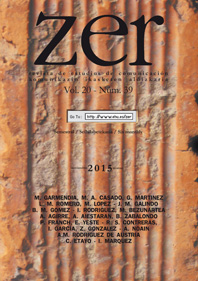Parody in American prime time animated comedy.The case of sitcom
##plugins.themes.bootstrap3.article.main##
##plugins.themes.bootstrap3.article.sidebar##
Published
09-12-2015
Beatriz María Gómez Morales
Abstract
American prime time animated comedy is characterized by its narrative structure based on parody other genres and formats, mainly the sitcom. Through textual analysis, this research examines the parodic strategies used by the animated comedy to transform narrative elements that define the sitcom: happy endings, cyclic structure, stereotypical characters and canned laughter. The study concludes that TV parody, represented by animated comedies, works as a tool for reflection and review of fictional and entertainment contents.
How to Cite
Gómez Morales, B. M. (2015). Parody in American prime time animated comedy.The case of sitcom. ZER - Journal of Communication Studies, 20(39). https://doi.org/10.1387/zer.15519
##plugins.themes.bootstrap3.article.details##
References
ÁLVAREZ BERCIANO, Rosa (1999). La comedia enlatada: de Lucille Ball a Los Simpson. Barcelona: Gedisa.
BAJTÍN, Mijail (1987). La cultura popular en la Edad Media y en el Renacimiento. Madrid: Alianza.
BAJTÍN, Mijail (1989). Teoría y estética de la novela. Madrid: Taurus.
BOOKER, M. Keith (2006). Drawn to television: prime-time animation from The Flintstones to Family Guy. Westport, CT: Praeger.
BROWN, Les (1992). Les Brown's encyclopedia of television. Detroit: Gale Research.
BUTSCH, Richard (2005). Five decades and three hundred sitcoms about class and gender. En: EDGERTON, Gary R; ROSE, Brian G. (eds.). Thinking outside the box: a contemporary television genre reader. Lexington: University Press of Kentucky, pp. 111-135.
CASETTI, Francesco; DI CHIO, Federico (1999). Análisis de la televisión. Instrumentos, métodos y prácticas de investigación. Barcelona: Paidós.
CRISELL, Andrew (2006). A study of modern television. Thinking inside the box. New York: Palgrave Macmillan.
GENETTE, Gerard (1989a). Palimpsestos. La literatura en segundo grado. Madrid: Taurus.
GENETTE, Gerard (1989b). Figuras III. Barcelona: Lumen.
GÓMEZ MORALES, Beatriz (2014). La comedia animada de prime time en Estados Unidos. Un subgénero paródico, autorreflexivo e intertextual. En: Communication & Society /Comunicación y Sociedad, vol. 27, nº 1, pp. 127-142.
GORDILLO, Inmaculada (2009). Manual de narrativa televisiva. Madrid: Síntesis.
GRAY, Jonathan (2006). Watching with The Simpsons. Television, parody, and intertextuality. New York: Routledge.
HARRIES, Dan (2000). Film parody. London: BFI.
HUTCHEON, Linda (1985). A theory of parody: the teachings of twentieth-century art forms. New York: Methuen.
MARC, David (1997). Comic visions. Television comedy and American culture. Malden, MA: Blackwell.
MILLS, Brett (2005). Television Sitcom. London: BFI.
MINTZ, Larry (1985). Situation Comedy. En: ROSE, Brian G. (ed.). TV genres: a handbook and reference guide. Westport, CT: Greenwood Press, pp. 107-129.
MITTELL, Jason (2004). Genre and television: from cop shows to cartoon in American culture. New York: Routledge.
NEALE, Steve; KRUTNIK, Frank (1990). Popular film and television comedy. London: Routledge.
SNOW, Dale; SNOW, James (2009). Los Simpsons y la política del sexo. En: IRWIN, William; CONARD, Mark T.; SKOBLE, Aeon J. (eds.). Los Simpsons y la filosofía. Barcelona: Blackie Books, pp. 175-199.
STABILE, Carol; HARRISON, Mark (eds.) (2003). Prime time animation: television animation and American culture. New York: Routledge.
TURNER, Chris (2004). Planet Simpson: how a cartoon masterpiece documented an era and defined a generation. London: Ebury Press.
WILLIAMS-RAUTIOLA, Suzanne (2006). Animated fathers: representation of masculinity in The Simpsons and King of the Hill. En: BUCHAN, Suzanne (ed.). Animated Worlds. Eastleigh: John Libbey, pp. 95-112.
BAJTÍN, Mijail (1987). La cultura popular en la Edad Media y en el Renacimiento. Madrid: Alianza.
BAJTÍN, Mijail (1989). Teoría y estética de la novela. Madrid: Taurus.
BOOKER, M. Keith (2006). Drawn to television: prime-time animation from The Flintstones to Family Guy. Westport, CT: Praeger.
BROWN, Les (1992). Les Brown's encyclopedia of television. Detroit: Gale Research.
BUTSCH, Richard (2005). Five decades and three hundred sitcoms about class and gender. En: EDGERTON, Gary R; ROSE, Brian G. (eds.). Thinking outside the box: a contemporary television genre reader. Lexington: University Press of Kentucky, pp. 111-135.
CASETTI, Francesco; DI CHIO, Federico (1999). Análisis de la televisión. Instrumentos, métodos y prácticas de investigación. Barcelona: Paidós.
CRISELL, Andrew (2006). A study of modern television. Thinking inside the box. New York: Palgrave Macmillan.
GENETTE, Gerard (1989a). Palimpsestos. La literatura en segundo grado. Madrid: Taurus.
GENETTE, Gerard (1989b). Figuras III. Barcelona: Lumen.
GÓMEZ MORALES, Beatriz (2014). La comedia animada de prime time en Estados Unidos. Un subgénero paródico, autorreflexivo e intertextual. En: Communication & Society /Comunicación y Sociedad, vol. 27, nº 1, pp. 127-142.
GORDILLO, Inmaculada (2009). Manual de narrativa televisiva. Madrid: Síntesis.
GRAY, Jonathan (2006). Watching with The Simpsons. Television, parody, and intertextuality. New York: Routledge.
HARRIES, Dan (2000). Film parody. London: BFI.
HUTCHEON, Linda (1985). A theory of parody: the teachings of twentieth-century art forms. New York: Methuen.
MARC, David (1997). Comic visions. Television comedy and American culture. Malden, MA: Blackwell.
MILLS, Brett (2005). Television Sitcom. London: BFI.
MINTZ, Larry (1985). Situation Comedy. En: ROSE, Brian G. (ed.). TV genres: a handbook and reference guide. Westport, CT: Greenwood Press, pp. 107-129.
MITTELL, Jason (2004). Genre and television: from cop shows to cartoon in American culture. New York: Routledge.
NEALE, Steve; KRUTNIK, Frank (1990). Popular film and television comedy. London: Routledge.
SNOW, Dale; SNOW, James (2009). Los Simpsons y la política del sexo. En: IRWIN, William; CONARD, Mark T.; SKOBLE, Aeon J. (eds.). Los Simpsons y la filosofía. Barcelona: Blackie Books, pp. 175-199.
STABILE, Carol; HARRISON, Mark (eds.) (2003). Prime time animation: television animation and American culture. New York: Routledge.
TURNER, Chris (2004). Planet Simpson: how a cartoon masterpiece documented an era and defined a generation. London: Ebury Press.
WILLIAMS-RAUTIOLA, Suzanne (2006). Animated fathers: representation of masculinity in The Simpsons and King of the Hill. En: BUCHAN, Suzanne (ed.). Animated Worlds. Eastleigh: John Libbey, pp. 95-112.
Issue
Section
Articles
(c) UPV/EHU Press

